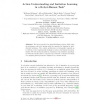Free Online Productivity Tools
i2Speak
i2Symbol
i2OCR
iTex2Img
iWeb2Print
iWeb2Shot
i2Type
iPdf2Split
iPdf2Merge
i2Bopomofo
i2Arabic
i2Style
i2Image
i2PDF
iLatex2Rtf
Sci2ools
90
Voted
ICANN
2005
Springer
2005
Springer
Action Understanding and Imitation Learning in a Robot-Human Task
We report results of an interdisciplinary project which aims at endowing a real robot system with the capacity for learning by goaldirected imitation. The control architecture is biologically inspired as it reflects recent experimental findings in action observation/execution studies. We test its functionality in variations of an imitation paradigm in which the artefact has to reproduce the observed or inferred end state of a grasping-placing sequence displayed by a human model.
Related Content
| Added | 27 Jun 2010 |
| Updated | 27 Jun 2010 |
| Type | Conference |
| Year | 2005 |
| Where | ICANN |
| Authors | Wolfram Erlhagen, Albert Mukovskiy, Estela Bicho, Giorgio Panin, Csaba Kiss, Alois Knoll, Hein T. van Schie, Harold Bekkering |
Comments (0)

